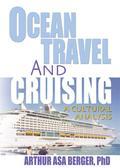A one-of-a-kind analysis of ocean cruising! In Ocean Travel and Cruising: A Cultural Analysis, noted author Arthur Asa Berger turns his critical eye to the phenomenon of ocean cruising. This academically solid yet reader-friendly book brings a multidisciplinary cultural studies approach to the subject, examining ocean cruising from economic, semiotic, sociological, psychoanalytic, and marketing perspectives, and offering insights not provided by the more traditional sociological approaches to the subject. You'll explore cruise demographics, the relationship between cruising and gender, the sociology of dining on cruise ships, hedonism and pleasure seeking, the compulsion to cruise, consolidation in the industry, the exploitation of workers on cruise ships, and a great deal more. Here's a section-by-section rundown of what's in store for you and your students in this one-of-a-kind new text: The Economics of Cruising examines cruise categories, industry consolidation, worker exploitation, and ways that cruise lines make money aside from ticket sales. This section also compares the costs of cruises vs. land-based vacations and fills you in on the typical weekly food and beverage consumption of the Carnival line's complement of ships, which sheds light on how a cruise line can, for a mere $10, provide a food array that would cost a restaurant or hotel $33 to $40. Signs at Sea-The Semiotics of Cruising provides you with a quick primer on semiotics and then discusses the cruise ship as a sign system and then breaks the system down to its component parts, discussing dining rooms, cabins/staterooms, dress codes, spatiality, luxury signifiers, the perceived elitism of the cruise experience, the role of photography, and more. A Sociological Analysis of Cruising explores cruise demographics and their meaning, time budgeting on cruises, the sociology of dining, new trends in cruising, and the meaning of gender in relation to ocean cruising. A particularly intrigui


